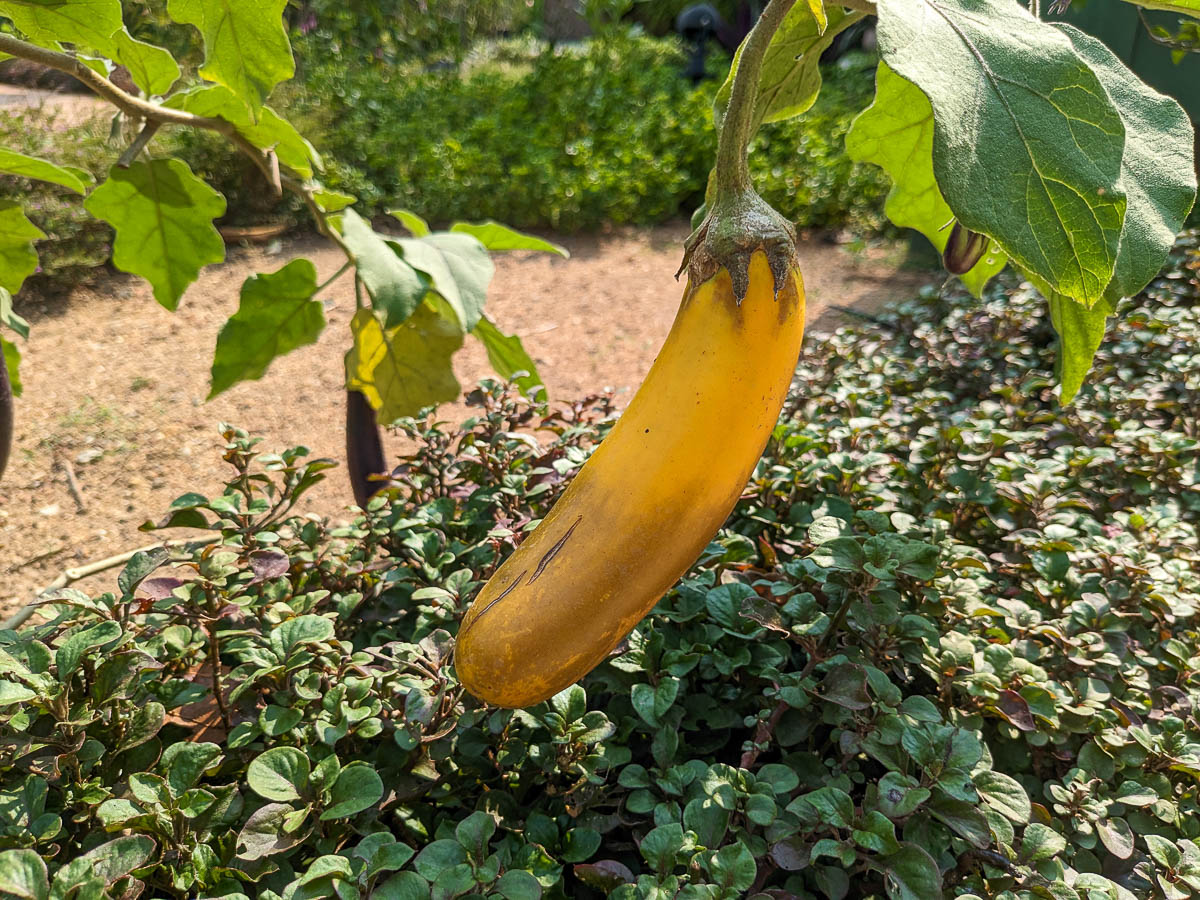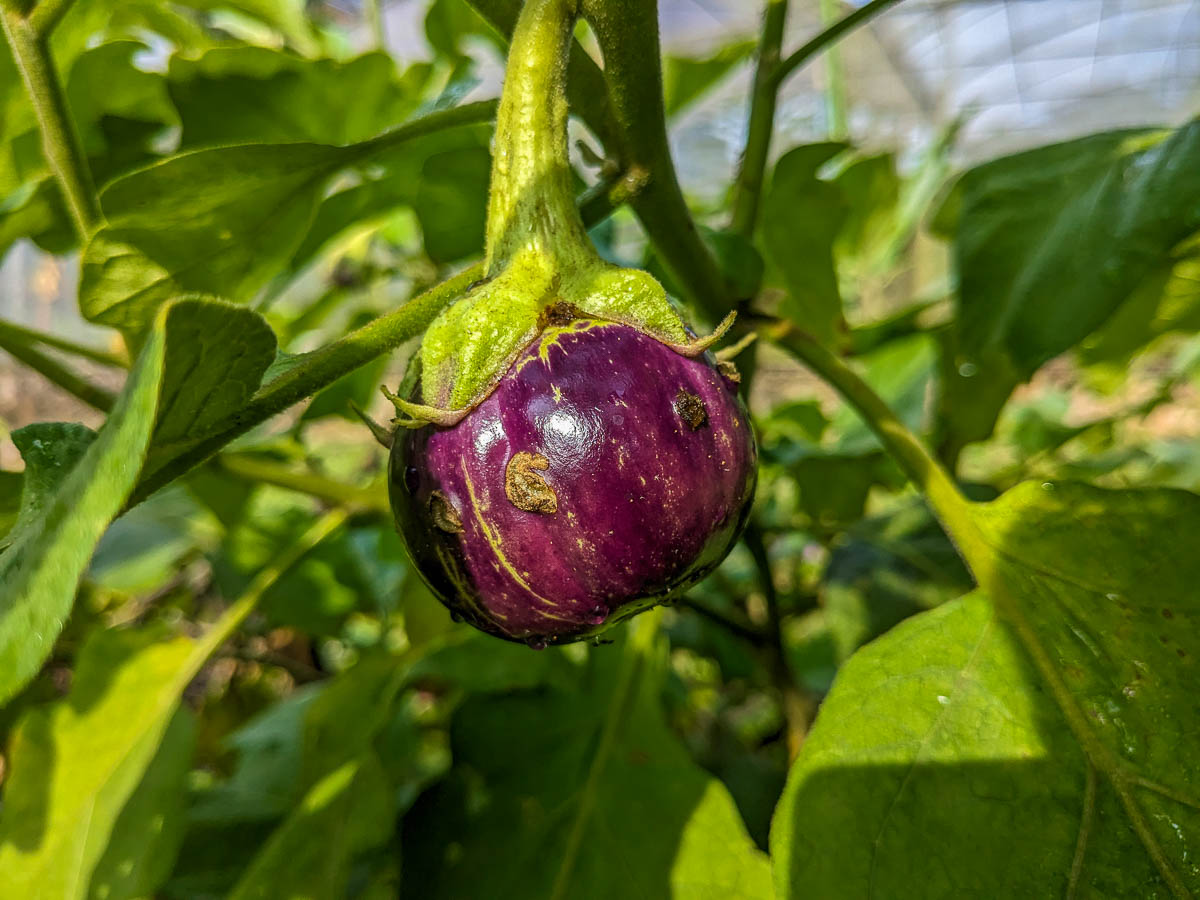Brinjal
Brinjal (Solanum melongena)
Other common names: Eggplant, Aubergine, 茄子
.jpg)
Brinjals are one of the most common crops you see in Community Gardens in Singapore as they can grow quickly into productive bushes and are relatively pest resistant. With a wide variety of cultivars, brinjals come in colours ranging from dark purple to white, and can be round, egg-shaped, or oblong. The fruits are eaten while they are immature, and can be roasted, stewed, or made into sauces.
A perennial crop, these plants are a popular mainstay in edible gardens of all sizes. Eggplants in true ground can produce fruit for a few years, while those in pots and can produce fruit for more than a year if cared for properly.
This plant is part of the Solanum or Nightshade family, which includes other popular edible fruits like Tomatoes and Chillies.
Sun and soil needs:
.jpg)
This plant does best in full sun gardens with a minimum of 6 hours of direct sunlight. This plant can also grow with 4-5 hours of direct sunlight and at least 6 hours of indirect sunlight, but will produce less fruits.
Plants do best in pots with loamy soil at least 15cm deep, or in true ground.
Sowing seeds:
Seeds can be sown directly into pots or the ground around 15-30cm apart. Lightly water the soil until damp, once a day. Seeds should sprout within two weeks.
The seedlings are generally resilient to most environmental factors but may be vulnerable to being eaten by snails or birds. Protect your young plants with a DIY cloche or netting.
Growing:
Brinjals will produce more flowers and thus more fruit when fed with fertilisers high in Phosphorus and Potassium. Plants can be fertilised once a month after the plant produces its first flower for a fuller crop.
As with all members of the Nightshade family, this plant is buzz-pollinated and produces the most fruit when bees are around to pollinate it. Growing more bee-attracting plants within the garden will encourage pollination.
This plant grows as a small shrub, producing large leaves on a few branches. It is a good practice to prune regularly and remove dead leaves to improve ventilation and allow light to reach more of the plant.
Harvesting:
.jpg)
Plants can be harvested for fruits around 3 months after sowing. The best time to harvest the fruit is in the early morning, before 9am.
Eggplants are generally eaten when they are immature. Immature fruits should be picked when they are glossy, and have a soft, spongy texture.

Ripe fruits are usually a dull brown or yellow, and will rapidly become soft and wrinkly. Ripe fruit should not be eaten, but can be harvested for seeds to be used for immediate planting.
Harvest cycle:
| Growing period | Sowing to germination | Germination to transplanting | Transplanting to first harvest | Total sowing to first harvest |
|---|---|---|---|---|
| Approximate time | A week to 3 weeks | 2 to 3 weeks | 2 to 3 months | 3 to 4 months |
Check out our sowing and harvest planner to schedule your growing!
Propagation:
Brinjal are grown from seed.
Common problems & solutions:

If your plant has few to no flowers, you can fertilise the plant with fertilisers high in phosphorus and potassium. These nutrients encourage root and flower growth, which are important for the plant to produce more fruit.
As with all members of the Nightshade family, this plant is buzz-pollinated and produces the most fruit when bees are around to pollinate it. Growing more bee-attracting plants within the garden will encourage pollination.
Aphids, Mealy Bugs, Whiteflies, and Scale Insects often infest the plant if it has underlying problems like repeated wilting from heat stress. Mechanical pest control methods like pruning the infested parts are the best methods for managing these pests in the short term, but resolving the underlying problem will prevent them in the long term.
Wilting leaves during hot weather is a sign of heat stress. Increase the number of times the plant is watered daily, and apply mulch at the base to prevent water loss.
These plants can get blossom end rot, which shows up as dark, sunken blotches at the end of fruits. It is a symptom of a lack of calcium reaching the fruit, which is usually caused by a lack of water or inconsistent watering. Keep your soil moist but not waterlogged and take care to water more often during the dry season.
Fruit flies can lay eggs in the fruit, resulting in larvae damaging the fruit and creating spots on the skin. Wrap your fruit in netting when it starts to develop from a fertilised flower, ideally after all the petals have dropped off.

